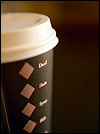Coffee Shop Privacy
February 17, 2006
There's nothing like the smell of fresh coffee, the buzz of activity and hipster music (or your iPod) to cure those office blues. Being able to carry your laptop to the coffee house and still put in a day's work is one of the best things to come out of the Wi-Fi revolution.

|
|
Go for the coffee, stay for the Wi-Fi.
|
Unfortunately, this can also set the stage for all sorts of trouble; like identity theft for starters.
Unlike a CAT5 connection, wireless cards shoot those ones and zeros shoot across the air letting anyone within range detect the signals. And as has been proven time and again, deciphering them isn't beyond the reach of even the most inexperienced hacker.
To make matters worse, a snooper may be right at the next table. Coffee shops aren't like an office park where you can ask security to check out that suspicious van.
Does that mean your traffic is all out there for everyone to see? Yes and no.
Your traffic is undeniably detectable, but you're in control of who is allowed to make heads or tails of it. Exerting that control is all up to you, however.
This week we spotlight a tutorial that will help wireless users practice safe wireless browsing while reaching for another cup.
Note: Any opinions expressed below are solely those of the individual posters on the AntiOnline forums.
Spotlight Thread:
Protecting Your Privacy at the Local Coffee Shop
First, an introduction from the tutorial's writer, Irongeek:
Coffee houses have become more and more popular recently among college students, especially shops that offer free Internet access to their patrons. Customers bring their laptops to these open Wi-Fi (802.11a, b, g, n) hotspots to surf the web and communicate with distant friends, but few realize that what they do on these public Wi-Fi hotspots may be viewed by other voyeuristic coffee connoisseurs.
The focus of this article is on keeping others from intentionally violating your privacy while you use your laptop at a local coffee house, but most of the principles also apply to other wireless networks you may encounter.
Now a look at an obvious avenue of attack.
Open file shares
One of the first things you should be aware of is open file shares. I’m just going to cover Microsoft Windows computers since they are the most common, but similar problems can exist for OS X and Linux systems too. While at a local hotspot some deviant folks may run a tool like Softperfect’s NetScan to find all open Windows file shares on the local network and see which ones they can read or write to. Less technical attackers may just look in “Network Places” and see what shows up.
But let's get to the really scary stuff...
Sniffers
Probably the biggest threat when using open Wi-Fi networks at coffee shops are deviant users running sniffers on the network. Pay special attention to this section if you’re interested in avoiding identity theft where attackers use your credentials to access bank, credit and other sorts of personal accounts. Sniffers (also known as Network Analyzers) are a category of software that can look at network traffic, decode it, and give meaningful information about what kind of data is crossing a network. While sniffers have a lot of legitimate uses they are also useful tools for deviant computer users since they can be used to pull plain text passwords off a network, watch instant message conversations (AIM, Yahoo, MSN, etc), read e-mail messages or view web sites that other hotspot users are visiting.
So how do you take your wireless security? Regular or decaf? Discuss here.
